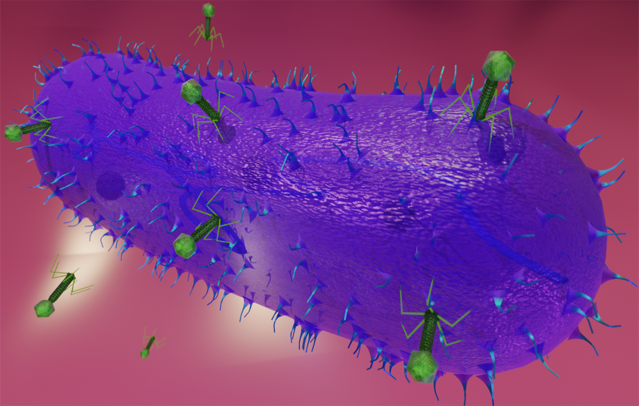Genetics
Say Hello to the Human Virome
Microbes living in your gut are not all bacteria and fungi. Most are viruses.
Posted June 13, 2022 Reviewed by Devon Frye
Key points
- Trillions of bacteria live in your colon, but there are ten times as many viruses.
- Most of the viruses live on and in gut bacteria.
- Some viruses can kill their host bacteria, possibly replacing antibiotics.
- Viruses may have as big an impact on your health as bacteria.
Big fleas have little fleas upon their backs to bite them, and little fleas have lesser fleas, and so ad infinitum. —Augustus De Morgan
The thirty trillion bacteria living in your gut? Old news.
As we now know, every one of us hosts a marvelous cosmopolitan collection of bacteria in our colon. It is wildly complex and tightly interconnected. It’s also nothing new: The very first animals to rise out of the primordial soup had microbial hangers-on and they have been co-evolving ever since.

Less well-known is that for each bacterium in your gut, there are a dozen viruses helping them, infecting them, or killing them. Welcome to the world of the virome. Technically, the virome is a part of the microbiome, but it is far more mysterious. Amazingly, just like bacteria, viruses can even affect your mood and cognition.
Research has shown that we acquire our microbiota within the first 1,000 days of our lives. Much of that comes from a microbial starter kit included in mother’s milk. That kit includes viruses quietly camping out inside bacteria.
After birth, it only takes a week to find millions of viruses in each gram of a baby’s poop. In a sign of how new this field is, the most prevalent virus—making up some 90 percent of the total—was only identified in 2014. It is a bacteriophage, or simply phage, that thrives on a complex and often fatal relationship with a genus of bacteria known as Bacteroides.
Bacteroides is the major genus of bacteria in the gut and is generally well behaved, at least in the gut. Outside of the gut, it is a potent pathogen, so a virus that limits its population may be a good thing. With conditionally pathogenic bacteria, as with real estate, it’s all about location, location, location.
An Explosive Relationship
When phages go on the attack, they start by injecting their modest set of genes into a host bacterium. Phages are marvels of minimalism, unable to even replicate their own chromosomes. For reproduction, they depend on hapless bacteria, which dutifully reproduce viral genes as if they were their own and thus produce a large contingent of new viruses that crowd the bacterial cell body.
Ultimately the overstuffed bacterium bursts open like a scene out of "Alien." The viruses swarm out, eager to infect more bacteria. This is a trick that fascinates scientists, who are keen to find a way to kill pathogenic bacteria without using antibiotics that tend to generate antibiotic resistance.
The beauty of a phage attack is that one dose is sufficient: the phages multiply on their own and hunt down their hosts with a vengeance until they are wiped out. There is no equivalent of antibiotic resistance with phages, which seem to act upon all or none. They are very specific about who they select to host their invasion. Other bacteria are left alone—another big difference from antibiotics, which are often broad-brush medications that kill the good with the bad.
Viruses are Potent
Some of the most dangerous diseases in the world, like typhus and cholera, are blamed on bacteria, but that turns out to be a bad rap: It is not the bacteria but the viruses that infect the bacteria that cause disease. The bacteria are just as much victims as we are.
But viruses don’t need a bacterial host to become pathogenic; they can attack us directly. Viruses are behind herpes, measles, AIDS, hepatitis, colds, flus, and COVID. And because bacteria aren’t involved in these diseases, antibiotics can't touch them.
However, like most of the microbiome, not all viruses are evil. Phages may play a dramatic role in exploding pathogenic bacteria, but there is another, more subtle side to their behavior. Phages can take up residence in the bacterial host and settle down without mischief. This may be how most phages enter the microbiota, as passive companions. That can be a gift to a bacterium, as the virus may add useful genes. In fact, some of the antibiotic resistance that we observe is due to genetic transfer from viruses. In this sense, viruses act like software updates, making changes whether we want them or not.
Viruses do the same to our own cells, and scientists have discovered that almost 10 percent of our “human” genes are from viruses that insinuated themselves into our germline and stayed there. In fact, the placenta appears to be an ancient gift from a virus that changed the biology of mammals forever.
Viruses can also pick up genes from their hosts that get incorporated into their “children.” That means that viruses could be important vectors for gene transfer, possibly responsible for a large portion of evolutionary growth and diversity.
Remarkably, viruses can also affect our brains. A small study showed that people with increased levels of two orders of virus, Caudovirales and Microviridae, had better cognition and memory. That shows that viruses can punch far above their weight, and ought to be treated with respect.
What to Do?
Despite their outsized influence on our health, we are abysmally ignorant of the inner workings of the virome. Scientists estimate that we have identified less than 1 percent of the viruses in our bodies. The rest of the viral load in the human gut is dark matter, figuratively and literally. Their genes simply don’t exist in any database.
What can you do to protect yourself against the rogue viruses and encourage the good ones? First, keep your microbiome in top shape by daily consumption of fiber and ferments. Fiber, polyphenols, prebiotics, and probiotics are all known to improve the composition of the microbiota. With a proper diet, the whole microbiota is stabilized. That stability implies that phages are comfortable with the arrangement, resting quietly in their bacterial hosts, and not blowing them up.
This sort of stalemate is probably the best we can hope for right now. But stay tuned—although bacteria have been hogging the stage for decades, viruses are poised to make a grand entrance.
References
Adiliaghdam, Fatemeh, and Kate L. Jeffrey. “Illuminating the Human Virome in Health and Disease.” Genome Medicine 12, no. 1 (July 30, 2020): 66.
Dutilh, Bas E., Noriko Cassman, Katelyn McNair, Savannah E. Sanchez, Genivaldo G. Z. Silva, Lance Boling, Jeremy J. Barr, et al. “A Highly Abundant Bacteriophage Discovered in the Unknown Sequences of Human Faecal Metagenomes.” Nature Communications 5, no. 1 (July 24, 2014): 4498.
Mayneris-Perxachs, Jordi, Anna Castells-Nobau, María Arnoriaga-Rodríguez, Josep Garre-Olmo, Josep Puig, Rafael Ramos, Francisco Martínez-Hernández, et al. “Caudovirales Bacteriophages Are Associated with Improved Executive Function and Memory in Flies, Mice, and Humans.” Cell Host & Microbe 30, no. 3 (March 9, 2022): 340-356.e8.
Wexler, Hannah M. “Bacteroides: The Good, the Bad, and the Nitty-Gritty.” Clinical Microbiology Reviews 20, no. 4 (October 2007): 593–621.




